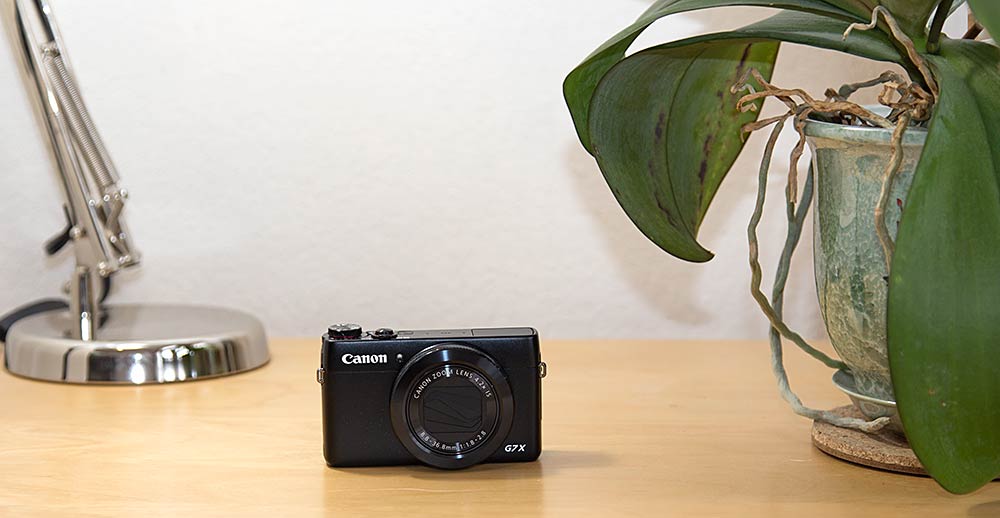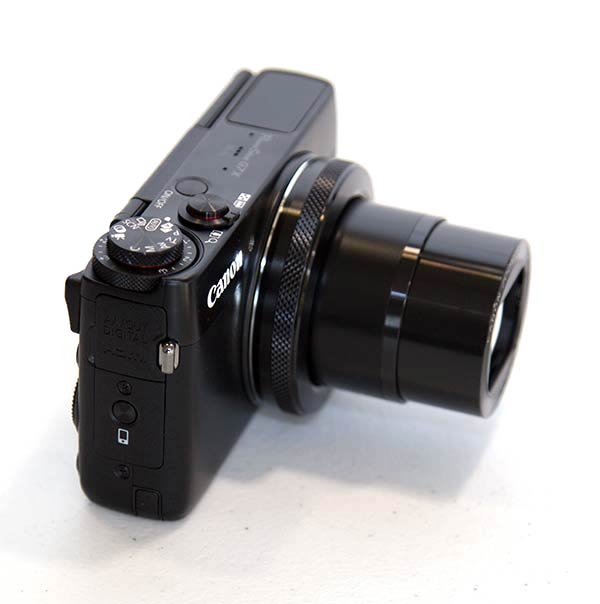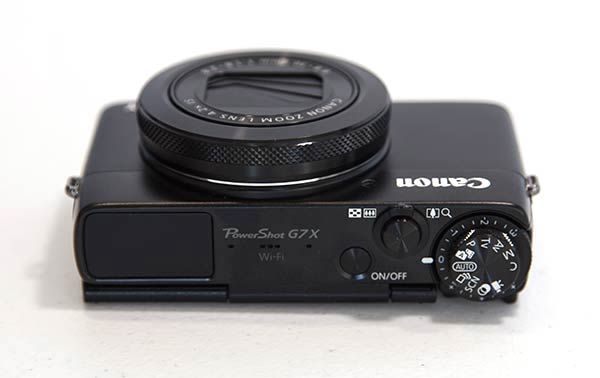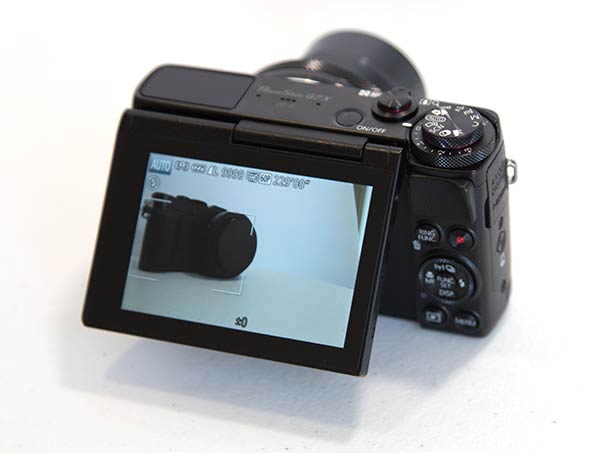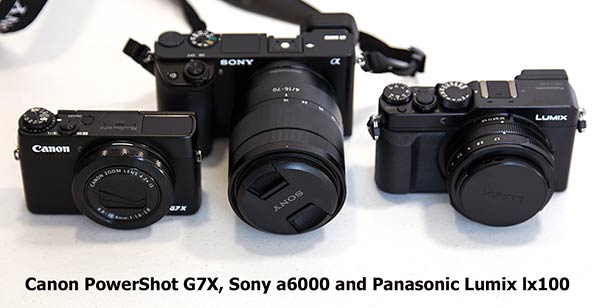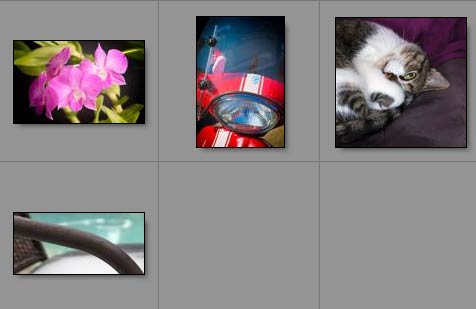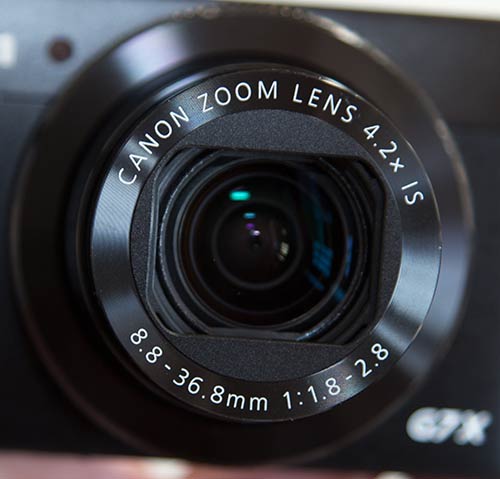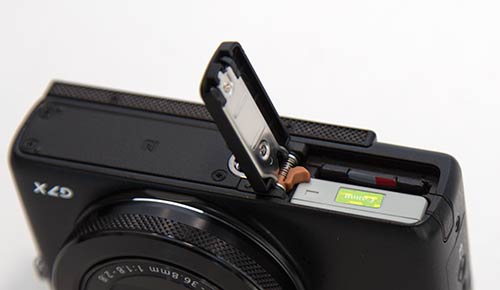
|
|
|||||||
|
Home > Camera Reviews > Canon PowerShot G7X
Canon PowerShot G7X
What's Hot: Relatively long zoom lens, wide aperture, excellent 1" sensor, touch screen works well for focus. What's Not: No EVF, LCD tilts up but not down. RAW not available in auto mode.
Reviewed February 27, 2015 by Lisa Gade, Editor in Chief (twitter: @lisagade, Instagram lisagadeMTR)
|
|||||
|
Times are changing: when it comes to high quality compact cameras and ILCs, many folks think of Sony first. Indeed the Sony Cyber-shot RX100, now in its third generation, is the compact camera to beat in the under $1,000 price range if extreme pocketability plus image quality are your thing. At the high end, there's the insanely good and expensive Sony RX1 full frame pocket camera at $2,000 and for bridge camera users it's hard to beat the Sony RX10 (especially if video is your thing). Canon is trying to grab some of that market share with their new PowerShot G7X. It's the same size as the RX100, has a metal body and it even uses the same excellent 1" Sony 20MP sensor that's in the RX100 mark II and III. It's interesting to see Canon and Nikon use Sony sensors, to say the least, and while several of Sony's businesses are ailing, their sensor division and camera division are thriving. Just because the Canon G7X has a Sony sensor, that doesn't mean you're getting an RX100 mk III clone at a $100 discount. The G7X uses Canon's DIGIC 6 image processor and their own lens. That's fine with us because we're fond of Canon's distinctive colors and very good JPEG rendition. They also make some excellent lenses and I suspect the fairly priced array of great Canon lenses is half the reason their dSLR business continues to thrive. The GX7 is smaller than Canon's other try at a pocket high quality compact, the G1X mk II and it has much more modern tech inside. Our favorite feature beyond the fast f/1.8-2.8 24-100mm zoom lens is the tilting touch screen with features like touch to focus and focus pulling from one subject to another for video. Speaking of video, the G7X records video up to 1080p at 60fps with continuous autofocus in AVCHD (~33Mbps). That's better than the RX100 II's bitrate but not as high as the RX100 III when using the XAVC-S codec (50 Mbps). Honestly, for a pocket camera, the G7X has more than you need to make an excellent quality video, and none of the compacts have audio in for truly professional video creation.
Who is it for? The Canon PowerShot G7X, like the Sony RX100 and even the somewhat larger Panasonic Lumix LX100 and Canon G1X are for those who want the best possible image quality in the smallest possible package. If you've got money to spend, it's hard to find a more affordable or smaller point and shoot that comes close to the first two. The Canon, like the Sony, can be used like a point and shoot if you don't want to fiddle with settings (the Lumix LX100 is geared more toward photo enthusiasts). But you also have full manual control available, should you want to put your advanced skills to use. The Canon's auto mode does a good job of setting exposure, keeping a wide aperture for some background blurring, and it handles low light well. If you want to get a flower close up with bokeh that will make your iPhone 6 weep, go for aperture priority and zoom to 100mm on the Canon. So the PowerShot G7X is well suited to the point and shoot crowd looking for upgraded image quality. Alternatively, if you're a photo enthusiast who's looking for a portable counterpart to your big dSLR or ILC (interchangeable lens camera) with big lens and you don't want to let image quality and bokeh fall by the wayside, this could be your camera too. At 10.7 ounces and 4.06 x 2.38 x 1.59 inches, the camera is inconspicuous and easy to take anywhere. Build Quality and Controls It might be small but the G7X is built like a tank with a rigid black metal casing and a dense feel. It feels less delicate than the RX100 from the sturdy tilt screen joint to the rugged lens ring and beefier pop-up flash assembly. The drawback is that the flash supports aren't jointed like the Sony, so there's no "pull it back for homemade bounce flash". The flip-up screen only flips up and it doesn't have the RX100's scissor-like hinge that allows you to pull the screen out then down. Like all tiny cameras, those with good sized hands from average male adult hand size and up will find it hard to grip the camera and use the small controls. There's no built in grip and the only concession to ergonomics is a rear upper right thumb pad. I found myself accidentally hitting the menu button at the lower right corner and the small dial controls are tactile but... small. This isn't a ding at Canon, rather it's the state of affairs with small cameras and basic physics. We do ding Canon for their EV dial: it's placed just where you'd want it surrounding the PASM dial and it handles +/- 3 EV in one third EV increments which is wonderful, but the ring is so stiff you'll wear some skin off your thumb trying to turn it. The front lens ring can handle assignable functions--again, that's awesome. But it's such a ratchety and loud thing that it's nearly impossible to use for manual focus and it's even notchy for step zooming. It's as if they looked at Sony's video-oriented silent ring with its lack of tactile feedback and went too far in the opposite direction.
Other than quibbles with stiff lens and EV rings, controls are logical and well laid out. The PASM plus scene modes and a C customizable option are standard stuff, and Canon's use of the menu button for base functions coupled with the function set button for quick shooter's settings works easily enough. There's a ring function button to make it easy to change the lens ring's function on the fly (ISO, zoom, aperture, shutter speed and more), and the usual red record button for shooting video. Buttons feel solid and are workable with thin gloves. It's hard to fault the G7X's build quality.
Shooting Experience and Image Quality The Canon PowerShot G7X rivals the Sony RX100 mk 3 for image quality, and that's a good thing since both take some of the best images we've seen from a compact camera with an integrated zoom lens in this price range. If you're replacing a 3-5 year old camera, you're in for a treat in terms of speed, automated features, filter effects and image quality. The unusually wide aperture lens combined with the 1" sensor that's significantly larger than point and shoot sensors yields brighter and sharper shots. Though both the Canon and Sony RX100 share the same f/1.8-2.8 aperture, the Canon keeps the lens wider open all the way up to 50mm, allowing for noticiably more background blur. The 20MP BSI sensor grabs oodles of detail so you can crop and maintain a sharp image. We have Canon's typically yummy colors that tend toward warmth and a cinematic sensibility with plenty of saturation. In contrast, Sony's images are cooler and I see it as a great street shooter in terms of color, while the Canon is well suited to portraits and flower shots. I've shot quite a bit with the Sony RX100 mk I and III, and between the Canon G7X and Sony mk III, it's close to a dead heat for image sharpness, focus speeds (neither are fast compared to a dSLR and are thus not ideal for sports photography) and vividness. Shots up to 3200 ISO are quite usable and the camera does its best to keep ISO lower--surprisingly low thanks the BSI sensor. 125-1600 ISO is the ideal range if you don't want too much noise in RAW files or too much JPEG smudging. We managed some night shots with a subject's face lit only by a monitor and Canon's JPEG engine did a surprisingly fantastic job of eradicating noise in the near-black background without making our subject's face look too smoothed and painted. Of course, no subject will mind the JPEG engine smoothing away skin flaws. When shooting the street at night, some detail is lost in the JPEGs thanks to noise reduction, but RAW files maintained the detail (and modest noise that's correctable). Dynamic range is superb, especially for a compact camera, and there's plenty of shadow detail to coax out of RAW files. The PowerShot G7X rarely blows out highlights. For those who'd rather not process RAW images, HDR is available to bring out light and detail in high contrast settings. The G7X AWB (auto white balance) is good, though typical of Canon PowerShot models, tungsten lighting results in an overly warm and yellow look, while manually selecting tungsten can overcompensate and create too cool an image. That's our only complaint, and it's easily fixed if you correct in RAW. Speaking of RAW, it's maddening that you can shoot RAW (or simultaneous RAW and JPEG) in any mode but auto. The camera saves JPEGs quickly and is ready for the next shot in a reasonable amount of time, but RAW + JPEG saves are a little slow vs. the competition in this price range. There's no in-camera RAW processing so you'll have to rely on your desktop/laptop/tablet to process RAW files (there's an ACR profile for current versions of Photoshop and Lightroom).
The lens is excellent and it's a real point of competition vs. the Sony and Lumix LX100 since it reaches out to 100mm. For portrait photographers and those who want to take photos of kids and animals without getting distractingly close, the G7X is worth considering for the longer reach (or look at the older Sony RX100 II). Yes, as with other integrated-lens compact cameras, there's plenty of barrel distortion at wide angle if you look at the uncorrected images, but in-camera correction takes care of this and the corners are sharp enough to suit most folks. The touch screen is a pure joy to use for touch focus and the 1.04 million dot 3" LCD is quite good. Outdoor viewability is strong but like all LCDs, glare is an issue outdoors. Sadly, there's no viewfinder (not even as an optional accessory), and that could be a deal breaker for some. There's no hot shoe either; look to either the old RX100 mk 2 or the Panasonic Lumix LX100 if you need one. Images rival APS-C cameras equipped with typically slow kit lenses that don't allow for much depth of field. The G7X and Sony RX100 lack the depth of field to compete with shots taken with those bigger sensor cameras coupled with a better (faster) lens however. Macro shots on the Canon have noticably better background blur than the Sony, as do portraits taken at 90-100mm. But The G7X still can't compete with something like the Sony a6000 or Nikon D5300 with an f/4 or faster lens. In fact the Lumix lx100 is the only compact with non-removable lens that can hold its own against those cameras. For landscapes and street photography where you don't rely on narrow depth of field, the G7X is a fine stand-in for an APS-C dSLR or ILC and it captures an impressive amount of sharp detail for a 1" sensor camera. |
Deals and Shopping:
Advertisement |
||||
|
